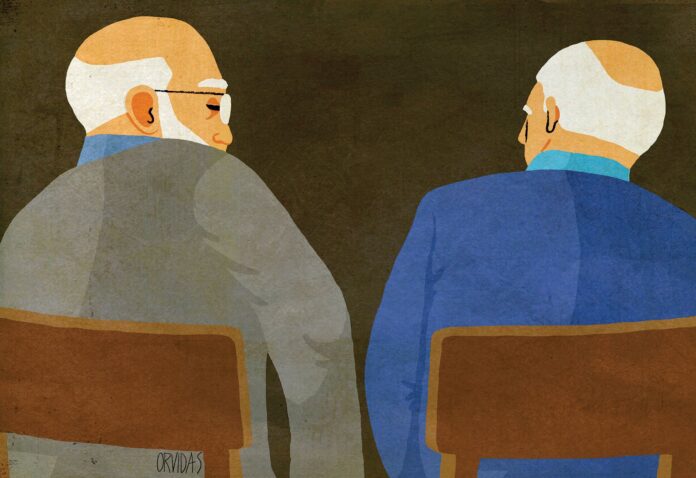The circle shrinks. As the years pass, older people attend too many funerals. Friendships that sustained them for decades lapse when companions and confidants retire or move away or grow ill.
These days Sylvia Frank, who moved into an independent living residence in Lower Manhattan in 2014, can email or call one longtime friend in Florida. Another, in Queens, is slipping into dementia and will most likely exclaim, “I haven’t spoken to you in months!” when, in fact, they talked the day before. But even at advanced ages, new relationships take root. Ms. Frank’s son kept telling her that a colleague’s cousin, Judy Sanderoff, was about to move into the same facility. They sought each other out. Now, Mrs. Frank, 91, and Ms. Sanderoff, 96, eat breakfast together almost daily; they have dinner, à deux or with other friends, many evenings. Ms. Sanderoff spent Thanksgiving with Ms. Frank’s family in Brooklyn.
Together, they have signed up for bus trips to the Museum of Arts and Design, to historic sites in Harlem, to a Pennsylvania casino. With Ms. Frank speaking into her friend’s good ear, they talk about news, politics and their families. When Ms. Frank didn’t come downstairs for breakfast one recent morning, Ms. Sanderoff was on the phone to ask why. “At this age, it’s said you make acquaintances,” Ms. Sanderoff told me. “But I feel I’ve made a true friend in Sylvia.”
The way we prioritize friendships as we age may evolve. Laura Carstensen, a Stanford University psychologist, developed an influential theory called “socioemotional selectivity”: As people sense their remaining time growing brief, they shed superficial relationships to concentrate on those they find most meaningful. “They invest more in their remaining connections,” said Gary Kennedy, director of geriatric psychiatry at Montefiore Medical Center. “They optimize friendships, rather than try to maximize them.”
A tide of recent research underscores the importance of such bonds. Social isolation and loneliness can take a serious toll on elders, psychologically and physically. (Over 75, almost a quarter of men and nearly 46 percent of women live alone, the Census Bureau reports.) They also suffer higher mortality rates and increased risk of depression, cognitive decline and illnesses like coronary artery disease. Loneliness brings its own dangers; studies have shown associations with higher blood pressure, with nursing home admissions, with risky health behaviors like inactivity and smoking, and with dementia.
It’s heartening, therefore, to hear Ms. Youner kvell about her new friend, Shirley Zweibel, 87. “We’re constantly having a conversation,” Ms. Youner said. “Shelley can’t stop talking, that’s the reason,” Ms. Zweibel bantered. But, she added: “When you’re a kid and say you have a friend, you don’t even know what that means. At this age, it goes deeper.”
In fact, older adults have probably developed important relational skills, said Rosemary Blieszner, distinguished professor of human development at Virginia Tech and a longtime friendship researcher. “They’re pretty tolerant of friends’ imperfections and idiosyncrasies, more than young adults,” she said. “You bring a lot more experience to your friendships when you’re older. You know what’s worth fighting about and not worth fighting about.”
I couldn’t help noticing how many of the elders I spoke with had benefited from living in retirement communities and nursing homes — the very destinations so many people dread. They can provide proximity, shared activities and a larger pool of prospective friends. Flo Jakubiak, 85, left her condo in Sun City, Ariz., a year ago, when she felt herself growing socially cut off. “Nobody there knew I existed,” she said. In an independent living center, she has found friends with whom to share meals, movies and canasta games.
With strong evidence that friendship does, indeed, help save lives and promote health, social workers and researchers wish we could pay more attention to its central role. Activity directors, senior center staff members and family caregivers: Are there better ways to help elders stay in touch with the friends they care about, or meet new ones? We’re all willing to drive relatives to doctors’ appointments; driving them to spend time with friends may matter as much.
Last spring, Ms. Frank developed a serious heart problem and spent two weeks in a hospital, then another two in rehab. By phone, Mr. Lasky kept a worried Judy Sanderoff apprised of his mother’s condition. When he took her home after a month, they found an unexpected welcome. “Judy had put balloons on my mom’s front door,” Mr. Lasky said. “Then she came downstairs and they hugged each other for a good 10 minutes.”
Analysis
This article gives us a look at how older adults themselves view social isolation. Many of the articles I found were from the perspective of doctors, nurses, and family members of the aging population, but very few pieces actually lent themselves to the voices of those who were actually experiencing aging and the social isolation risks that come with it. I imagine these first person perspectives will be very important in designing a truly effective solution- one that relies heavily on the human touch and meaningful connections as a way to combat loneliness and social disconnectedness. The article also lists some of the medical risks related to social isolation in older adults, as well as resources I can use to look into these further. These are also important to consider, and it may be useful to look into these specific risks to find a solution that could address the root causes of these conditions as a way of prevention.




